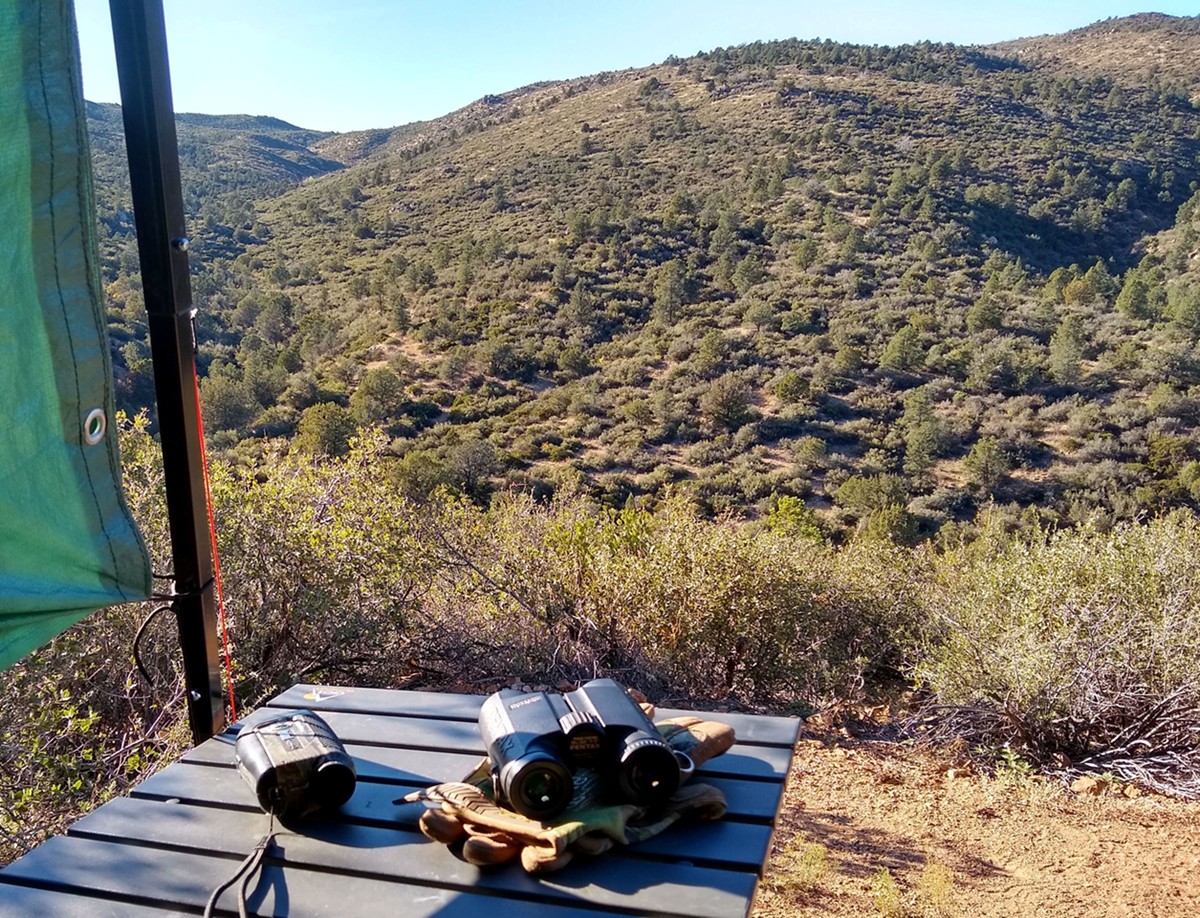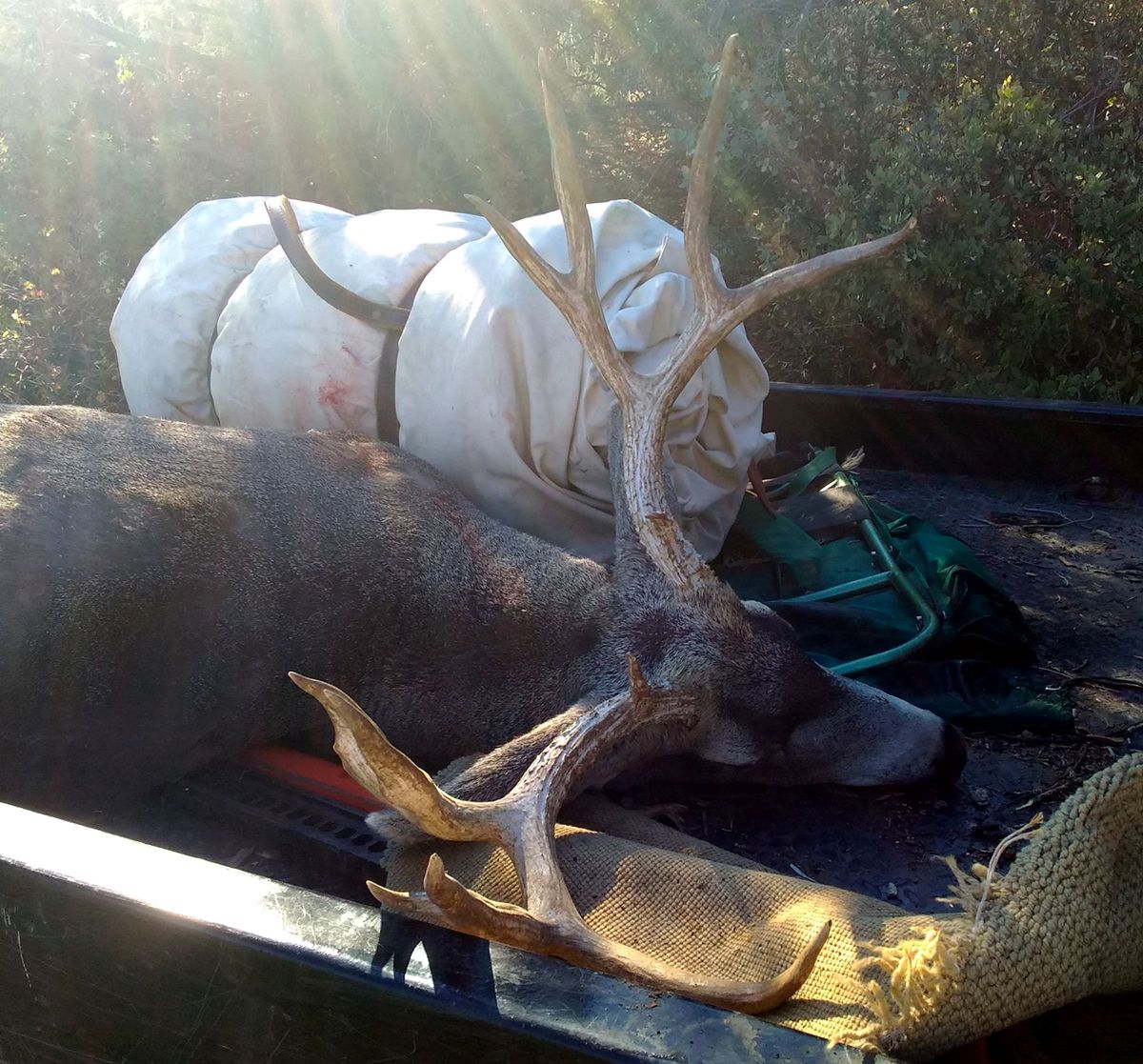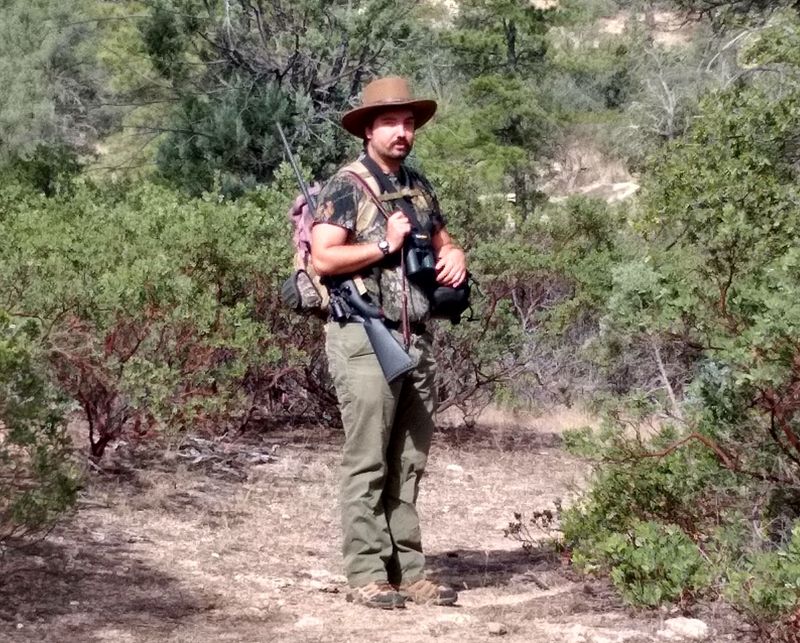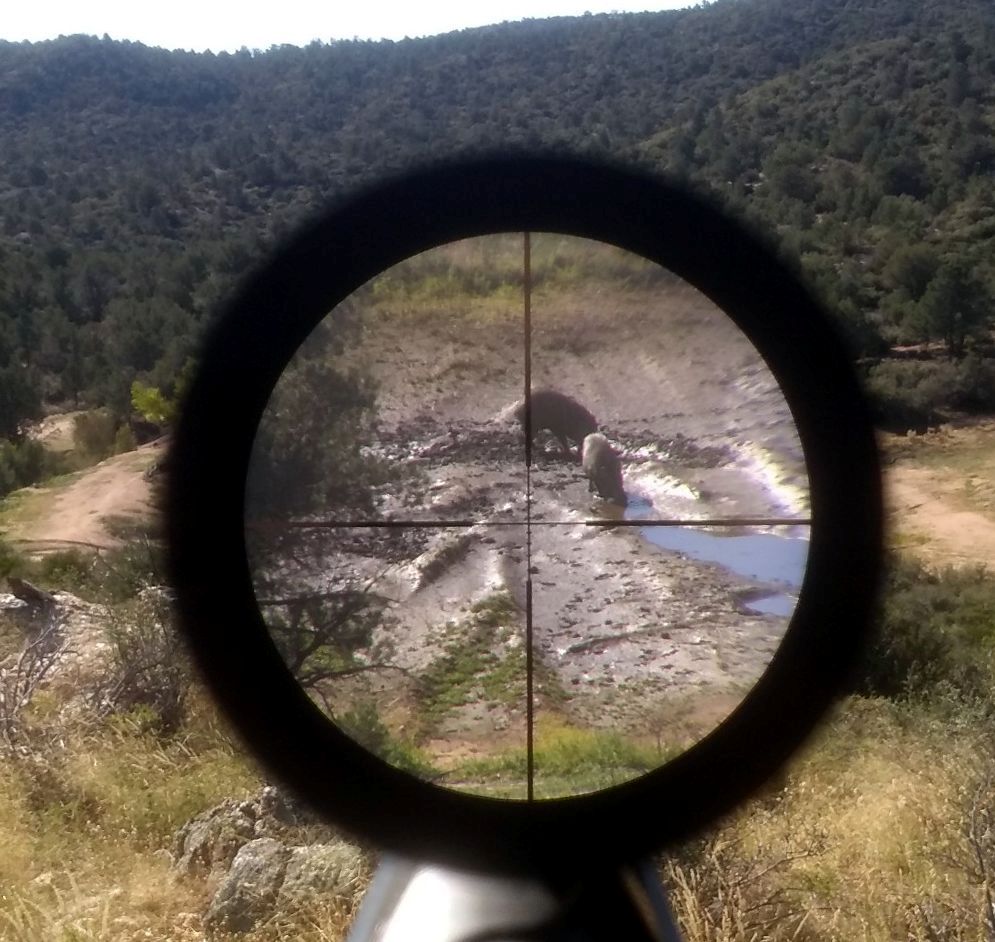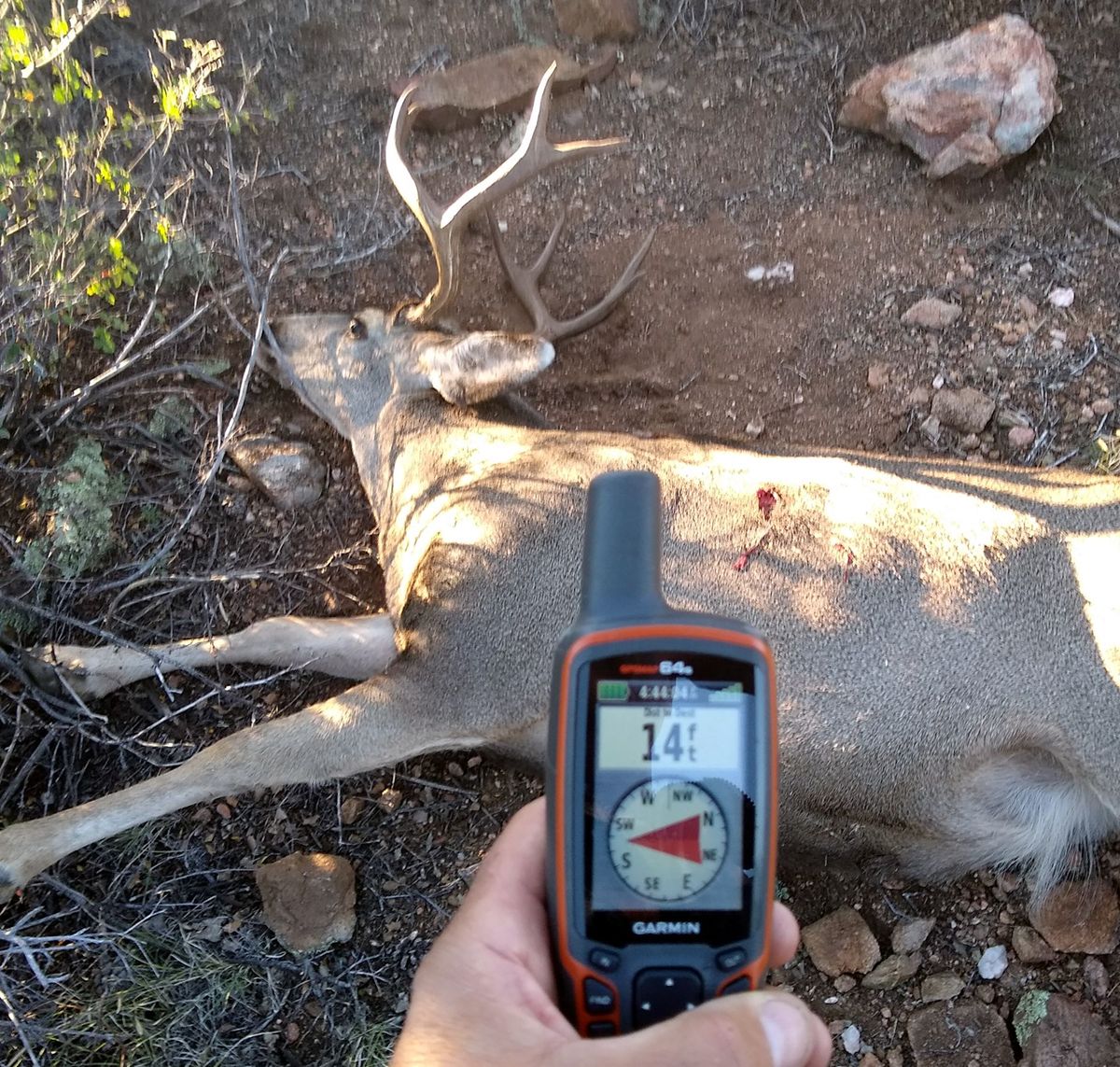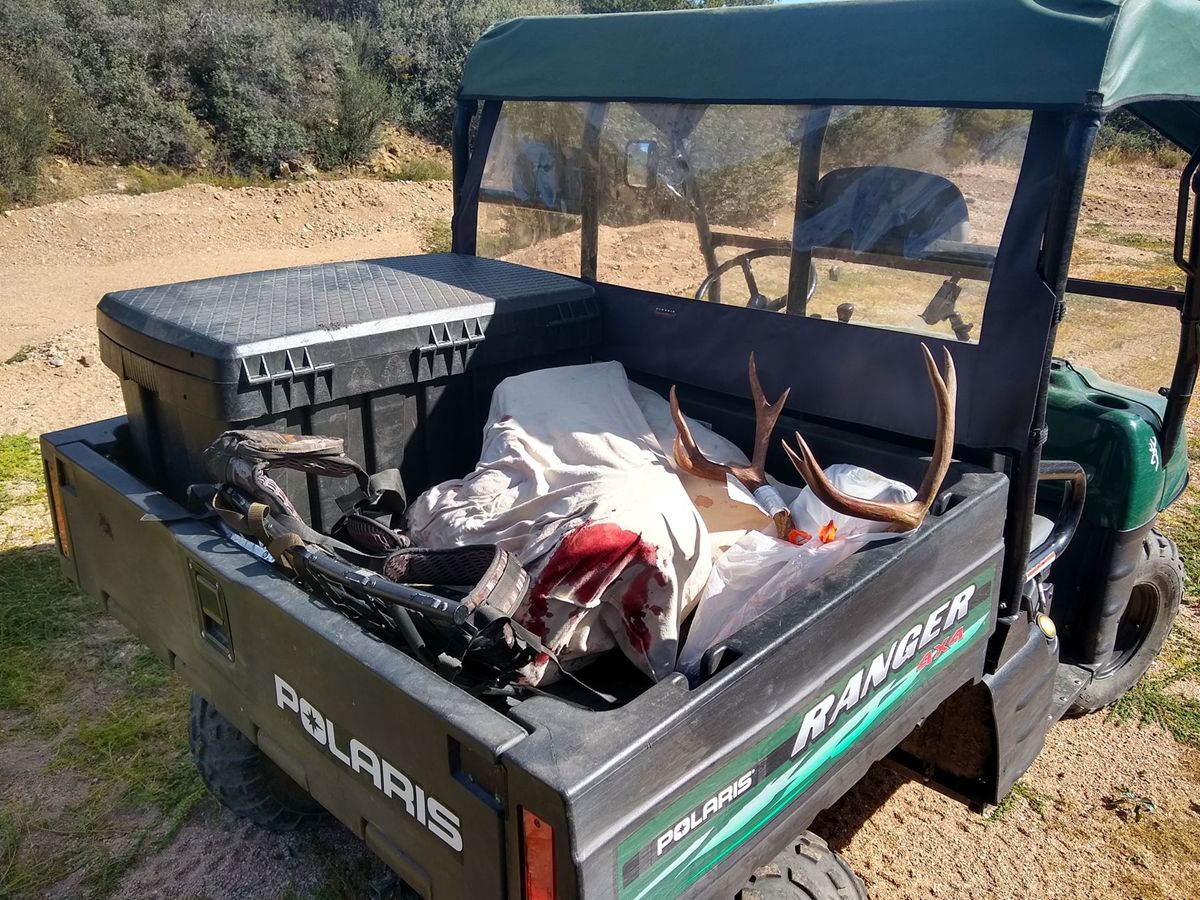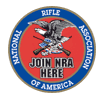Late October found me back in my favorite deer hunting canyon. This unit was second
choice on my draw application this year. My first choice was hunt unit 12A up on the
Kaibab Plateau, but that I got drawn for this area is perfectly fine.
My son Ben was drawn with me, but as in previous years, he could not get out of work
for the entire 10 day season like I could.
With a Friday opening day, I went up early on Wednesday. I wanted to get there early
enough to secure my favorite camping spot. After setting up my camping trailer on
Wednesday before noon, I had lunch, then drove down to my Mom’s house, less than an
hour away, to retrieve the Polaris Ranger to bring to camp as well.
Access to the canyon depends on the rugged little hunting buggy. The trail in is very
rocky, steep, skinny, with off camber sections, deep ruts, and stair-step rock shelves
to negotiate. I would use the buggy on Thursday to set up two blinds in the canyon, as
I had in previous years.
The first blind is set up on a slope above a water hole, about 150 yards from the
water’s closest edge. If you’ve read my previous stories, then you might remember that
I call this blind the “Sniper’s Lair.” The occupant of the Lair is protected from sun
and rain by a camouflage tarp that is stretched out underneath a juniper tree. A large
bush behind the deer sniper breaks up the hunter’s silhouette.
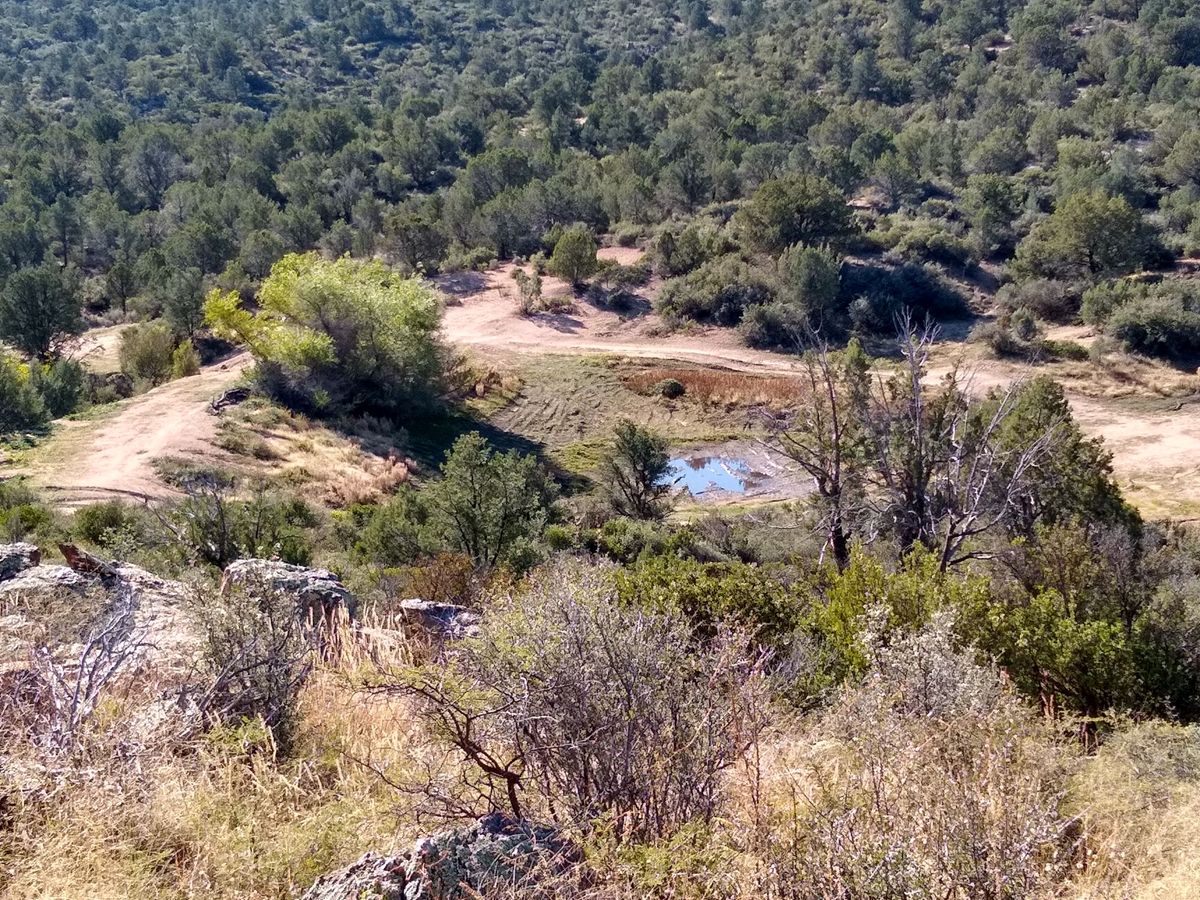
Waterhole almost dry
|
I park the Ranger about .3 miles up the canyon from the water hole, then hike down the
rest of the way. Two surprises greeted me when I got there: First, in the last year,
someone had brought in a bulldozer and moved some dirt around. The berm was expanded
and the hole was apparently dredged out somewhat. What was even more surprising was
that there was almost no water. I had never seen it this low. With all the rain we had
seen in Phoenix in October, I expected the tank to be full, full, full. But no.
As it turned out, in the days that we were there, Ben and I would watch the hole go from
holding a little water, to nothing more than mud. But still I set up the blind.
The second blind is set up where the Ranger is parked, just down slope from the Ranger,
overlooking south facing slopes on the opposite side of the canyon. Here, I use a mini
accordion-style canopy frame (6’x6’), draped with another camouflage tarp. This blind
location is called “the OP” or “OP 5400,” for Observation Post and the elevation.
Both blinds are equipped with tripod chairs with backrests, and a Caldwell DeadShot
FieldPod. Additionally, the OP is equipped with an aluminum folding table. This is a
handy place to put your binoculars, range finder, and your drink while you are having
lunch. The Sniper’s Lair has a natural table in the form of a large rock.
Ben would not be able to join me in camp until Friday night, so he would miss opening
day. For opening day, I arrived at the Sniper’s Lair before sunrise and made myself
comfortable. I spent the whole day here. I packed in a MRE for lunch. I hoped that
since there was still a little water here, that the nearby canyon bottoms would be just
as dry, so there could be a chance for some action.
In the mid-afternoon, I saw another hunter and his wife come in. Up in the Lair, they
had not seen me, but I saw them. I clipped an orange hat to the front of the tarp. That
was enough. I watched the guy pan over with his spotting scope to investigate the flash
of unnatural color. In a few minutes, I watched them back out of the scrub, back to the
rough trail, then hike up and out. Coming in, they should have seen the Ranger parked,
so they must have had some idea that another hunter was in the vicinity.
That was the only action that I had on opening day. Fortunately, that was the only
competition for the canyon that we had all hunt long.
Last year was a totally different story. Last year in the canyon, opening day was filled
with yahoos all day long. In fact, I came across another hunter and his wife on the drive
in, in the dark. We had some words. He thought that since he parked first, a half mile
away from the water hole, that he had rights to the hole, even though he wasn’t there yet.
I was still on my way down to my parking spot, which if I followed through, I would have
reached the hole first.
Instead, I compromised with him, and let him have the water hole on opening morning. I
would take my upper blind at the Ranger parking spot. Wouldn’t you know it, as the lights
came on, I heard at least three shots down at the water hole. Later that morning, he and
his wife brought the buck out. Here is that buck that could’ve been mine: →
Alright, I didn’t feel too sorry for myself. It was actually his wife that shot the buck,
hence all the shooting before the buck came to bag. I was quite happy for her, actually.
No, I never got another chance at a buck during the 2017 season. There’s always next year
– this year.
Ben did show up at camp later that evening, right on schedule. We talked about the plan
for the next day. He decided that he wanted to sit over the water hole, even though I had
texted him the photo of the almost dry hole earlier in the day. I would take the OP. He
wanted to break the vigil at lunch time and come back to camp. OK, that was fine with me.
As I glassed from the OP when the first rays of sun lit the opposing slopes on Saturday
morning, I spotted a very nice rack – just the rack, walking around in the tall scrub
around 600 yards away. My heart started beating rapidly. The rack was taller and wider
than my 2014 buck, which is my biggest to date. But what to do about it? 600 yards is
too long a poke for me. Anyways, there was no deer body visible to shoot at.

The “OP” – One orange guy line so that I don’t
trip over it when accessing the OP in the dark
|
I started to work my way down the slope in front of me. The vegetation around here is
shoulder to head high – and thick! My slope was steep. Not even half way down to the
bottom, I came to the conclusion that this was a fool’s mission. There was no way that
I could get within shooting distance through this stuff, down my slope and up the
opposite slope, and hope that he would stick around and pose for me. I swam back up
through the brush and got back to my chair. But the image of that great rack bobbling
above the brush continued to haunt me.
I pulled out my GPS to waypoint the buck. Because my GPS has a 3-axis electronic
compass built-in to it, it has a feature called “Sight ‘n Go.” I have found that this
is an extremely valuable feature to have and to know how to use around here. I
waypointed a monster bull elk that I spotted from here in 2015.
You point your GPS where you want to set a waypoint. You then push a button to lock in
the bearing to the target. Since I had ranged the buck, I knew his exact distance. I
typed in 600 yards. The GPS created a waypoint where the buck was standing. Now I
could actually navigate to that spot.
Ben hiked up the trail back to me at the Ranger parking spot around 11:30. From here
it’s about a 15 minute ride back to camp. Over lunch I told him that I was going to
spend the afternoon hiking up the mountain behind the Sniper’s Lair toward the buck’s
position, and just hang around up there to see if I could stumble into him.
It was good to spend some time wandering instead of just sitting. I definitely got
within shooting distance of the buck’s position by GPS, but never saw him.
For Sunday’s hunt, the plan was to swap blinds and to stay all day, packing MREs for
lunch. Ben saw some does from the OP that day. I saw nada. But it was another good
day in paradise nevertheless.
For Monday, we decided to change things up. We would not hunt the canyon at all. I
told Ben that I wanted to spend a day hunting around the “Quad Camp” area that I wrote
about in the August newsletter. We had never hunted there and I wanted to check it out.
This area is about a 16 mile one-way trip from our camp. We made the trip in the Ranger.
The Ranger’s prowess off road on skinny nasty trails would be needed for the final 3
miles to the Quad Camp.
It was to be sort of a low-key day of hunting, not hard core at all. We didn’t get up
extra early, nor did we stay out until the last light left the sky. As a matter of fact,
upon parking the Ranger at Quad Camp to start our hike, I found out that I had forgotten
to load my rifle into the gun boot on the side of the Ranger! Ben had his rifle, so he
was the only hunter on this day. No problem. Ben has still never taken a deer, so I was
quite happy that he still had an opportunity, even if I didn’t.
We hiked in over a mile on a barely known trail to a “lost corral.” That’s my name for
it. I found this faint unmarked trail and corral by studying Google Earth. The corral
is next to a creek with a trickle of water in it. Seemed like a good place to check out.
It was a beautiful area with ponderosas, junipers and manzanita, plus some granite boulders.
We looked for a high vantage point from where a hunter could survey lots of surrounding
territory, but the vegetation was too tall and close for that. Any shots at deer would
likely be short range and fast around here.
We stayed for lunch in the field, then checked out a nearby tank which actually held a good
amount of water. There was a blind near the water’s edge. I asked Ben if he wanted to hang
around for a while, but he wasn’t interested in sitting. So we turned and headed back to camp.
On the ride back, we spotted a pair of does that were feeding close to the road. We parked
and watched them for a few minutes. They didn’t seem to mind.
Tuesday would be Ben’s last day to hunt. He was planning to hunt only the morning, have lunch
at camp, then head back to civilization in the afternoon. For his last hurrah, Ben again chose
to sit in the Sniper’s Lair above the water hole.
This morning, Ben saw wildlife come to water. He saw a herd of javelina come in. Some drank,
but some only wanted to roll in the mud, he said. He texted me this photo: →
We had seen pigs come to the water hole on several days last year as well. This was really
good news because guess what? We had applied for this unit for our spring javelina tags. We
did not know it at the time, but a couple of days after the hunt we would learn that we were
drawn for this unit.
After Ben left, I continued to hunt at the OP. That afternoon, some weather came in, a weak
cold front. While sitting there under cover, I had a very light rain come in for about 20
minutes. Certainly nowhere near enough rain to add any water to the water hole. It was a
little weird. Out in front of me was brilliant blue sky and sun-illuminated slopes. But
directly above me was a small grey cloud and the sound of light rain pattering the tarp.
So the next morning, Wednesday, Halloween day, the sound of a cold wind whooshing in the
trees kept me in my sleeping bag until the sun came out to warm the land a little. I threw
an MRE into my hunting pack and drove the Ranger out to the canyon. I decided to sit the OP
at first.
When I got to the OP, I found that the overnight wind had messed with the tarp. One grommet
had been ripped out, and the guy lines had to be reset. No big deal. Repairs were quickly made.
I lasted at the OP until about 9:30 am. The OP is on a north-facing slope. It gets no sun
in the morning. I was feeling a bit chilled due to the temperature drop brought by the cold
front. I decided to head down to the Lair which sits on a south-facing slope with exposure
to the sun.
I thought that there was a greater chance of spotting game from the OP, since the observable
land is so much greater there, but as I learned earlier in the hunt, being able to see game,
doesn’t necessarily mean that I would be able to capitalize. But I figured that there was
less chance of seeing any game at all in the middle of the day, so why not sit above the water
hole over lunch and keep warm?
I stayed comfortable at the Sniper’s Lair through lunch, but the water down below was all gone
now. Around 1:00 to 1:30, I decided to head back to the OP. The wind had died to almost zero
by this time. In 2015, I took a buck from the OP in a very similar situation, the day after a
cold front. Could it happen again? It could.
Around 3:30 pm, as the shadows began to lengthen, I told myself that it was time to get serious
about glassing. This is the time when the game starts to get active. I got behind the glass
and started scanning.
About a half hour later, I found something in my binoculars. It looked like a pair of crooked
light-colored legs. What was I looking at? As my eyes started to build the image in my brain,
I realized that was exactly what I was seeing – the two rear legs of a deer. The legs were
illuminated, but the front of the deer from the ham forward was in shadow. Antlers! The deer
was a buck! Decent antlers! There it was again – the sound of my quickened heartbeat pounding
in my ears.
I reached for the rangefinder on the small table. 280 yards. That’s a fair poke. I grabbed
the tripod that the rifle was sitting on and pulled it over to me. I got the buck in the scope.
Once more, to be sure, I ranged the deer. Still 280 yards. He momentarily turned to look
across the canyon toward me. I’m sure that he had no idea I was there. It was just a random
turn of the head I figure.
That one transcendent moment in a deer hunt had come. I once more got the deer in the scope.
I raised the aiming point to place the reticle’s first ballistic drop bar on the center of the
buck’s chest. There was no hurry as the buck wasn’t moving off. I released the safety. My
finger tightened on the rifle’s switch. The bullet was sent.
Instead of furiously working the bolt to rack in a second round, I just dipped my head in an
un-anticipated act of reverence for the moment. I knew the outcome without having to watch.
I had confidence in the rifle, the bullet, and in the sight picture as the rifle went off.
When I did look up again, I saw a small cloud of dust across the canyon, and a leg kicking
twice in the air. Then nothing.
I knew exactly what I needed to do next. I reached for the GPS. After obtaining a solid
lock on my position, I pointed it at the buck’s last known location. I could no longer see
him. I locked in the bearing and then typed in 280 yards for the distance. I had a waypoint.
I gathered up my rifle and hunting pack and walked up the slope to the Ranger. My pack frame
was ready. It had been in the back of the Ranger all hunt long. After driving down the trail
to the water hole, I checked the GPS. It showed that the buck’s waypoint was a quarter mile
up the draw. I took to foot with the GPS guiding me in. When the GPS reached zero, here is
what I found: →
From 280 yards away, using the Sight ‘n Go technique, the GPS and range finder had placed a
waypoint on the deer on the opposite slope that was accurate to within 14 feet! I was
thrilled and amazed. I just walked right up to him, no searching around required.
It would be hard to overstate how much this technique saved me from having to beat the bushes
to find the buck. As stated before, this area is thickly vegetated with chest- to head-high
brush. There are all kinds of little micro drainages and ridges on this side. Finding him
without the tech would have been very difficult.
I got to work field dressing him. By the time I was done, nightfall was just minutes away.
I decided to leave him here to cool overnight with the hope that no scavengers would find
him before I came back.
In the morning I was relieved to find him just as I had left him. I skinned him and halved
him where he lay. I got him to the Ranger in three trips: two half-deer trips, then one more
for his head and the rest of my gear.
When I got him to the meat processor’s, he weighed in at 116 pounds without the head. That
means that each quarter-mile half-deer trip down the thick, rough slope and down the rocky
canyon bottom to the Ranger was with around 60 pounds on my back (including the pack frame).
Getting the deer out and to the meat processor’s was how I spent my Thursday. I spent Friday
taking down my blinds then towing the Ranger back to my Mom’s place. On Saturday I packed up
camp and drove home.
While coming back to camp after dropping the Ranger off at my Mom’s, I came across a small
herd of javelina in the road just before camp. Ben and I will be back soon enough to see
whether or not we can find piggies again when it counts.
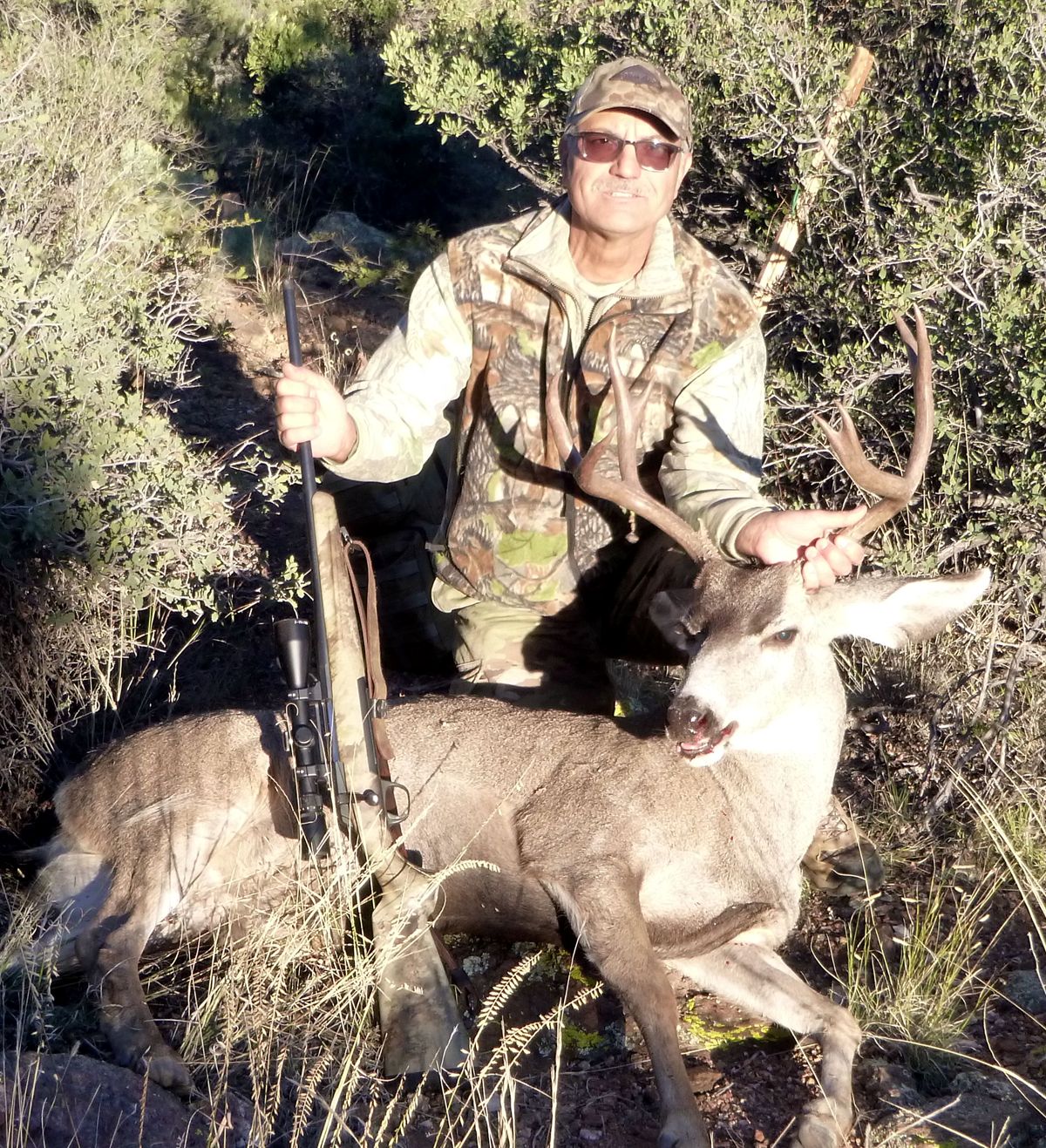
© Honeywell Sportsman Club. All rights reserved.

